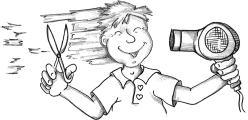Participle Clauses – Word Order in German Grammar

Participle clauses in German(Partizipialsätze) are dependent clauses that use a present or past participle. They always refer to the subject of the corresponding main clause. Participle clauses can make long dependent clauses shorter and help direct the reader’s attention to the main clause. They are relatively rare in modern German usage. We find them most often in novels and stories, but also in speech.
Example

Usage
There are two types of particple clauses in German grammar:
- Use the past participle, to show that the action in the participle clause took place before the action in the main clause.
- Example:
- Die Haare gewaschen, griff Susi zu Föhn und Schere.
-
First Susi washed her hair. Afterwards, she grabbed the hairdryer and scissors.
- Use the present participle, to show that both actions take place at the same time.
- Example:
- Den Föhn in der linken Hand haltend, schnitt Susi sich rechts die Haare ab.
-
Susi held the hairdryer in her left hand and she cut her hair with her right hand at the same time.
Construction and Word Order of German Participle Clauses
- There is no subject in a participle clause. The subject of the main clause is also the subject of the participle clause.
- The full verb is turned into a participle and placed at the end of the participle clause.
- Conjunctions and helping verbs, which are supposed to clarify temporal relationships, are not used in the participle clause. We can see from the participle whether the action takes place before (past participle) or at the same time (present participle) as the action in the main clause.
- Example:
- Während Susi den Föhn in der linken Hand hielt, schnitt sie sich rechts die Haare ab.
→ Den Föhn in der linken Hand haltend, schnitt Susi sich rechts die Haare ab. -
simultaneous action → present participle
- Nachdem sie die Haare gewaschen hatte, griff Susi zu Föhn und Schere.
→ Die Haare gewaschen, griff Susi zu Föhn und Schere. -
one action takes place before the other → past participle
Conjugating the Present Participle
We form the present participle by adding a -d to the end of the infinitive.
- Example:
- föhnen → föhnend
The only exception to the rule is the verb sein.
- Example:
- sein → seiend
Conjugating the Past Participle
The past participle of regular verbs is constructed by adding ge…t.
- Example:
- föhnen → geföhnt
- waschen → gewaschen
The past participle of most irregular verbs is constructed by adding ge…en.
Exceptions
- Many strong and mixed verbs change the word stem in the past participle. (see List of Irregular Verbs)
- Example:
- gehen – gegangen
- bringen – gebracht
- When the word stem ends in -d/-t, we add an -et for weak/mixed verbs.
- Example:
- warten – gewartet
- When the infinitive ends in -ieren, the past participle is not formed with ge-.
- Example:
- studieren – studiert
- When the verb is an inseparable verb, the past participle in not formed with ge-.
- Example:
- verstehen – verstanden
- When the verb is a separable verb, ge- comes after the prefix.
- Example:
- ankommen – angekommen
Use the Lingolia verb conjugator to check the conjugation of a particular verb.
Also you can download German keyboard.





























